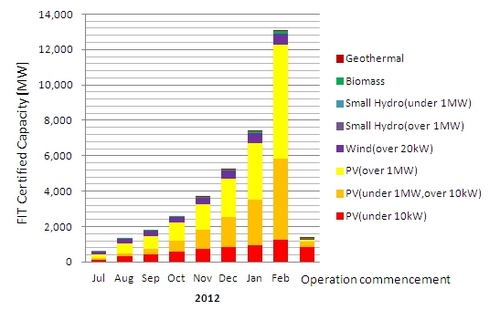September 2, 2013
One Year After Commencement of Feed-in Tariff, Grid Improvements Needed
Keywords: Government Policy / Systems Renewable Energy

Certification status (cumulative) and operation commencement status for systems under the feed-in tariff scheme (as of Feb. 28, 2013)
Copyright: Graph created by ISEP based on data from the Agency for Natural Resources and Energy, Japan
As of July, one year has passed since the start of full-scale implementation of the feed-in tariff for renewable energy in Japan. The capacity of power-generating systems certified under the scheme reached 13 million kilowatts as of February 28, 2013. This is equivalent to the renewable generation capacity installed across Japan over the previous 20 years. However, only about 10% of these systems are actually operating.
The current issue is improving the existing electrical grid. For example, by March 31, 2013, Hokkaido Electric Power Co. had received applications from large-scale solar power stations (systems with an individual output of more than 2,000 kilowatts) to sell a total amount of electricity reaching 1.57 million kilowatts. However, because the overall capacity of its electrical grid is relatively small, at 6 million kilowatts, the company has proposed to set a limit of 400,000 kilowatts for renewables, citing connection capacity limits. Without new solutions, the large-scale introduction of renewable energy in Japan could come to an abrupt halt.
Electricity generated by a distributed generation system that includes solar and other renewable energies tends to cause large fluctuations in voltage and a flow of power in the opposite direction of the normal flow (backfeeding), thus requiring electrical utilities to modify their systems under the feed-in tariff scheme. The scheme stipulates that renewable energy should be connected to the grid on a priority basis. In practice, however, electrical utility companies can reject renewables for their own reasons.
In order to avoid such situations, changes have been made to the scheme to allow backfeeding at distribution substations. In such areas as Hokkaido and Tohoku where power grids are underdeveloped despite favorable wind conditions, the creation of a mechanism for developing the grid has also started.
Written by Hironao Matsubara,
Institute for Sustainable Energy Policies
Related
"JFS Newsletter"
- 'Yumekaze' Wind Turbine Project Connects Metro Consumers and Regional Producers: Seikatsu Club Consumers' Co-operative
- Healthy Living through Improved Air-Quality and Environmental Protection: Programs to Prevent Health Damage from Pollution
- Well-being and Other Social Indicators: A Study of Five Local Governments Initiatives in Japan
- 1% Support Program in Ichinomiya City: Citizens Decide How to Use Their Tax Money
- Let's Enjoy Walking for the Benefits of Better Health -- Smart Wellness Point Project
Related
"Popular Articles"
- Japan Adopts Work-Life Balance Charter
- Tokyo Gov't Launches 10-Year Project for Green Metropolis
- FutureCity Initiative Holds International Forum Overseas for First Time
- 'Eco Action 21' Certification for Small/Medium Organizations
- OECD Selects Japan's Kitakyushu as First Model City for Green Growth in Asia


